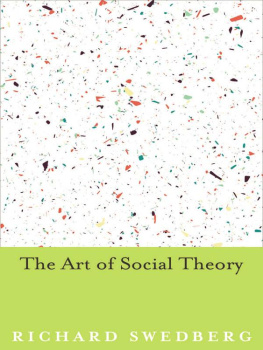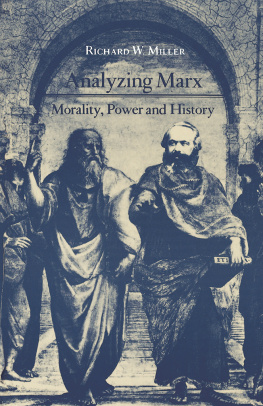Richard Swedberg - The Art of Social Theory
Here you can read online Richard Swedberg - The Art of Social Theory full text of the book (entire story) in english for free. Download pdf and epub, get meaning, cover and reviews about this ebook. year: 2014, publisher: Princeton University Press, genre: Romance novel. Description of the work, (preface) as well as reviews are available. Best literature library LitArk.com created for fans of good reading and offers a wide selection of genres:
Romance novel
Science fiction
Adventure
Detective
Science
History
Home and family
Prose
Art
Politics
Computer
Non-fiction
Religion
Business
Children
Humor
Choose a favorite category and find really read worthwhile books. Enjoy immersion in the world of imagination, feel the emotions of the characters or learn something new for yourself, make an fascinating discovery.
- Book:The Art of Social Theory
- Author:
- Publisher:Princeton University Press
- Genre:
- Year:2014
- Rating:3 / 5
- Favourites:Add to favourites
- Your mark:
- 60
- 1
- 2
- 3
- 4
- 5
The Art of Social Theory: summary, description and annotation
We offer to read an annotation, description, summary or preface (depends on what the author of the book "The Art of Social Theory" wrote himself). If you haven't found the necessary information about the book — write in the comments, we will try to find it.
The Art of Social Theory — read online for free the complete book (whole text) full work
Below is the text of the book, divided by pages. System saving the place of the last page read, allows you to conveniently read the book "The Art of Social Theory" online for free, without having to search again every time where you left off. Put a bookmark, and you can go to the page where you finished reading at any time.
Font size:
Interval:
Bookmark:
The Art of
Social Theory

The Art of
Social Theory

Richard Swedberg
PRINCETON UNIVERSITY PRESS
Princeton and Oxford
Copyright 2014 by Princeton University Press
Published by Princeton University Press, 41 William Street, Princeton, New Jersey 08540
In the United Kingdom: Princeton University Press, 6 Oxford Street, Woodstock, Oxfordshire OX20 1TW
press.princeton.edu
Jacket art Dmitrii Vlasov/Shutterstock. Jacket design by Pamela Schnitter.
All Rights Reserved
ISBN 978-0-691-15522-7
British Library Cataloging-in-Publication Data is available
This book has been composed in Garamond Premier Pro and Univers LT
Printed on acid-free paper.
Printed in the United States of America
10 9 8 7 6 5 4 3 2 1
For Mabel
Contents

The Art of
Social Theory

INTRODUCTION

Why Theorize and Can You Learn to Do It?
Why is it important to know how to theorize in social science? And is it a skill you can learnand perhaps also teach? Some interesting light was cast on these questions in the very strange way in which a crime was solved in the summer of 1879. The victim of the crime, and also the person who solved it, was philosopher and scientist Charles S. Peirce.
The crime took place on a steamship called Bristol , which was traveling between Boston and New York. At the time Peirce was thirty-nine years old and had just accepted a position as Lecturer in Logic at Johns Hopkins University. He was also working for the US government on the Coast and Geodetic Survey.
On Friday, June 20, 1879, Peirce boarded the boat in Boston. He would arrive the following day in New York, where he was going to attend a conference. When he woke up in his cabin the next morning he did not feel well. His mind was foggy, so he quickly dressed and took a cab from the harbor to the Brevoort House, a well-known hotel on Fifth Avenue where the conference was held.
After he arrived at the hotel, he discovered that he had forgotten his overcoat on the boat as well as an expensive Tiffany watch, to which a gold chain was attached. Peirce was especially unhappy at the prospect of losing the watch, since he used it as an instrument; it also belonged to the government.
Peirce rushed back to the boat, went to his cabin, and looked around. But the watch and chain and the coat were nowhere to be found. Peirce thought that one of the stewards must have stolen his belongings, since they were the only persons who had had access to his cabin. With the help of the captain he soon had the stewards lined up for questioning.
What then happened is strange. Instead of questioning the suspects in traditional fashion, Peirce proceeded as follows:
I went from one end of the row to the other, and talked a little to each one, in as dgag a manner as I could, about whatever he could talk about with interest, but would least expect me to bring forward, hoping that I might seem such a fool that I should be able to detect some symptom of his being the thief. (Peirce 1929: 271)
But this did not help, and Peirce had still no idea who the thief was. He decided to try something else:
When I had gone through the row I turned and walked from them, though not away, and said to myself. Not the least scintilla of light have I got to go upon. But thereupon my other self (for our communings are always in dialogues), said to me, But you simply must put your finger on the man. No matter if you have no reason, you must say whom you will think to be the thief. I made a little loop in my walk, which had not taken a minute, and as I turned toward them, all shadow of doubt had vanished. There was no self-criticism. All that was out of place. I went to the fellow whom I had fixed upon as the thief, and told him to step into the stateroom with me. (Peirce 1929: 271)
When Peirce was alone with the man, he did not try to make him confess. Instead he made an attempt to persuade the man to give back the stolen items. Peirce had a fifty-dollar bill in his pocket, which he offered to the man in return for his watch with the chain and coat.
Now, I said, that bill is yours, if you will earn it. I do not want to find out who stole my watch. You go and bring me the watch, chain and overcoat, and I shall only be too glad to pay you this fifty dollars and get away. (Peirce 1929: 271)
The man said that he did not know anything about the stolen goods, and Peirce let him go. He now decided he had to try something else and contacted Pinkertons, the famous detective agency. He explained what had happened to the head of the New York branch, a Mr. George Bangs.
Peirce told Bangs that he knew the name of the thief and wanted someone from Pinkertons to follow the thief when he got off the ship. The man will go to a pawnbroker, Peirce said, where he will get fifty dollars for the watch. When he pawns it, arrest him.
Bangs listened to Peirce and asked how he knew that this particular individual was the thief. Peirce answered, Why, I have no reason whatever for thinking so; but I am entirely confident that it is so (Peirce 1929: 273). Peirce added that if he was wrong, the man would not go to a pawnshop; and no harm would have been done by following him.
Bangs was not convinced. He told Peirce that his agency knew much more about thieves and criminals than Peirce did:
I am sure you have no acquaintance with thieves and are entirely ignorant of the species. Now we do know them. It is our business to be acquainted with them. We know the ways of every kind and every gang, and we know the men themselvesthe most of them. Let me suggest this: I will send down our very best man. He shall bear in mind and give full weight to your impression. Only let him not be hampered with positive orders. Let him act upon his own inferences, when he shall have sifted all the indications. (Peirce 1929: 273)
Peirce agreed, and a Pinkertons detective was sent to the boat the very same day, where he questioned all the stewards. The detective soon found out that one of the stewards had a criminal record, and he had the man followed.
The individual Peirce had singled out as the thief turned out to have been the personal valet of the captain for many years. When the theft took place he had also worked on a different deck than where Peirces cabin was located.
The detective followed the man with the criminal record, but this did not lead anywhere. Peirce asked Bangs what could be done next in this situation. Offer a reward of $150 to any pawnbroker who can give information about the watch was the answer.
Peirce followed the advice, and already the next day a pawnbroker reported that he had the watch. From the description that the pawnbroker gave of the man who had pawned the watch, Peirce immediately recognized the steward he had singled out as the thief.
Peirce now had his watch, but he still missed the coat and the gold chain that had been attached to the watch. To get back his remaining belongings he decided to go to the apartment of the thief, accompanied by a detective from Pinkertons.
Next pageFont size:
Interval:
Bookmark:
Similar books «The Art of Social Theory»
Look at similar books to The Art of Social Theory. We have selected literature similar in name and meaning in the hope of providing readers with more options to find new, interesting, not yet read works.
Discussion, reviews of the book The Art of Social Theory and just readers' own opinions. Leave your comments, write what you think about the work, its meaning or the main characters. Specify what exactly you liked and what you didn't like, and why you think so.








